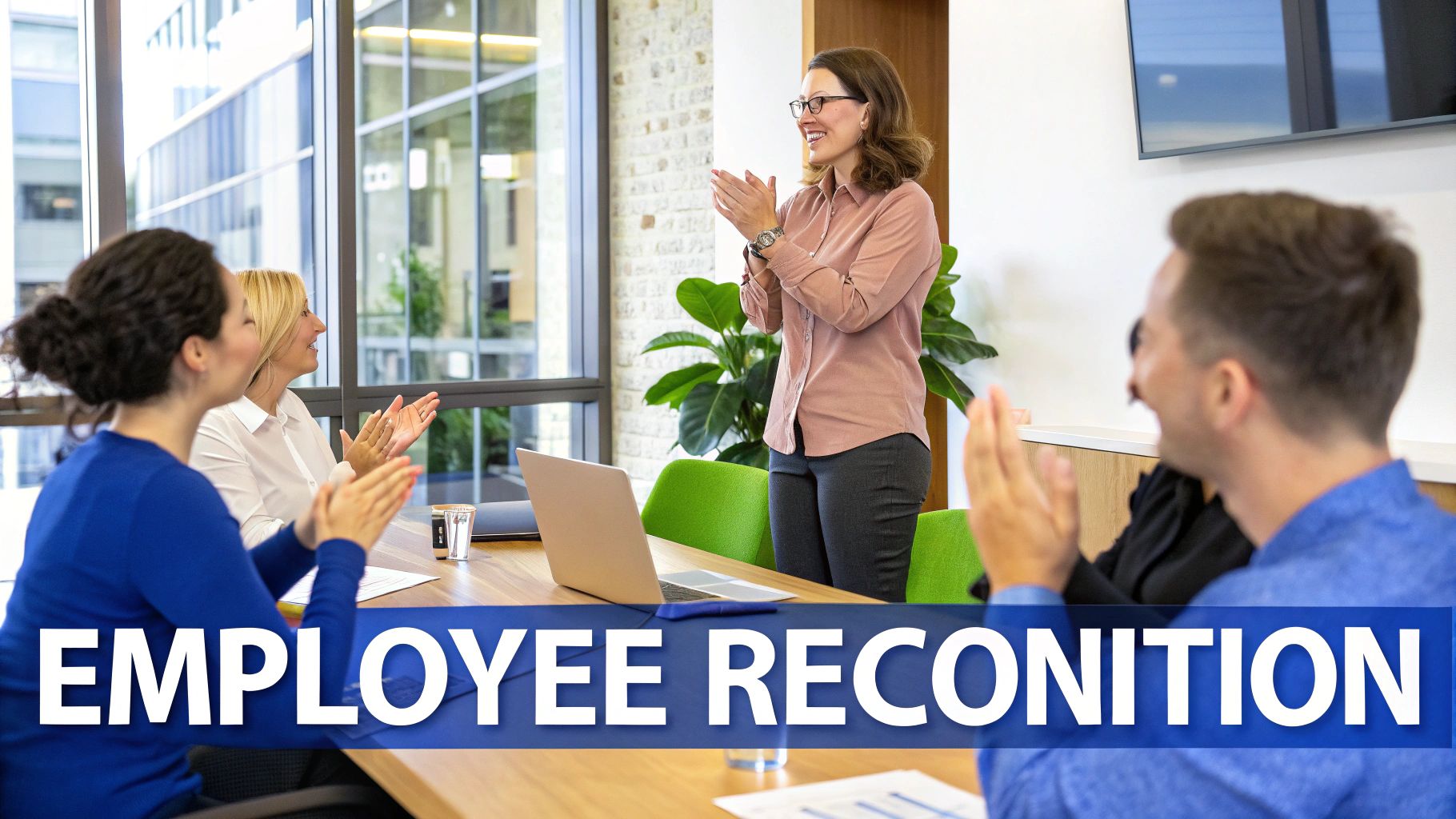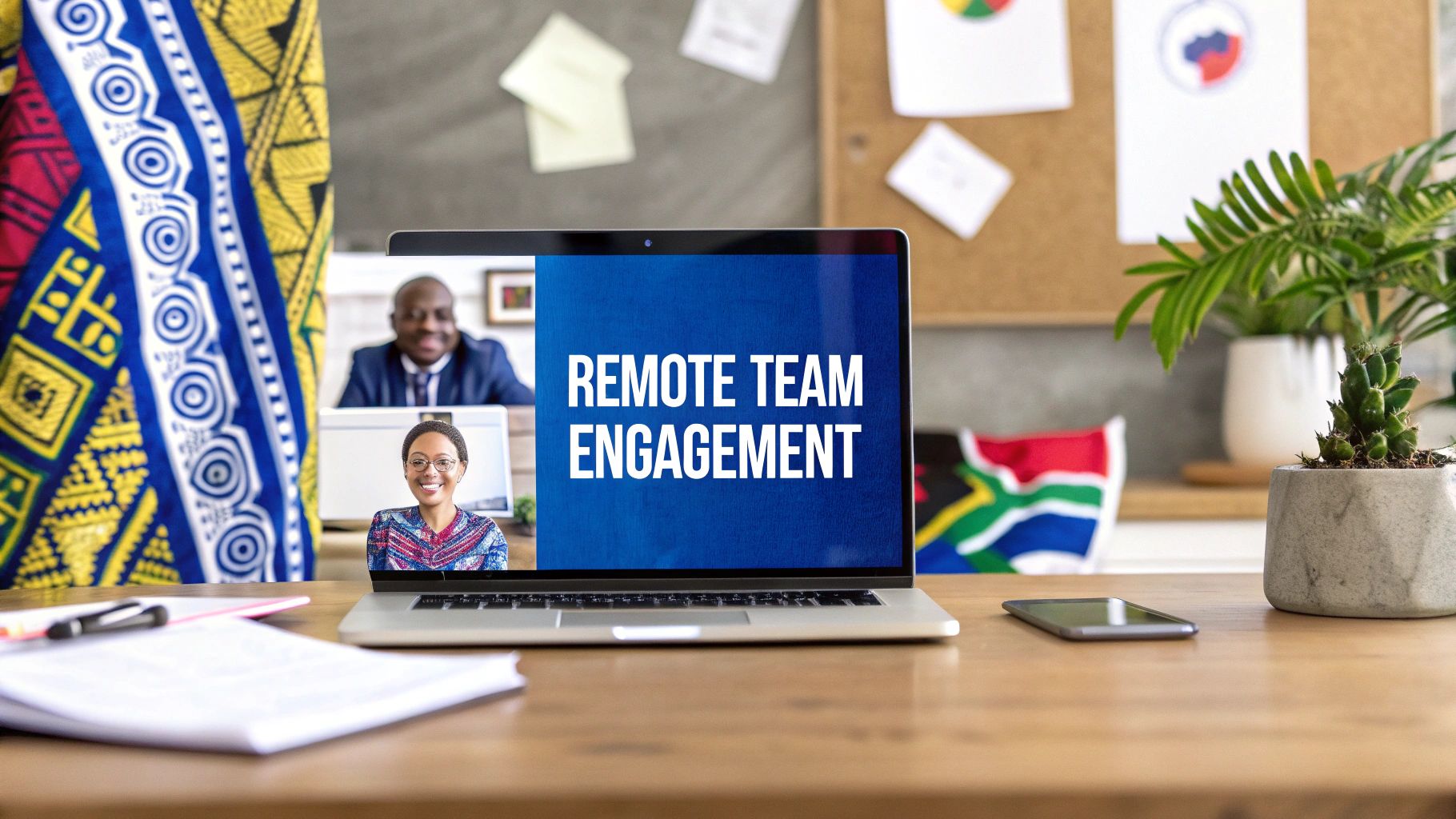Employee engagement has evolved from a simple HR metric into the central nervous system of a thriving organisation. For UK-based SMEs leveraging the incredible talent pool in South Africa, mastering engagement isn't just beneficial; it's the key to unlocking sustainable growth, innovation, and a formidable competitive edge. Traditional, office-centric strategies often fall short in a remote setting, creating disconnects that can stifle productivity and morale across different cultures and time zones.
This article cuts through the noise. We provide nine actionable, high-impact employee engagement best practices specifically designed to bridge the geographical distance. Our focus is on fostering a unified culture and empowering your remote South African professionals to do their best work. Forget generic advice; we will explore practical, culturally-aware strategies that go far beyond virtual happy hours, offering a concrete blueprint for building a truly connected and motivated distributed team.
Inside, you will discover how to implement structured one-on-one meetings that build trust, recognition programmes that resonate, and career development paths that retain top talent. We will cover everything from fostering genuine autonomy to promoting well-being and ensuring transparent communication. By focusing on these targeted approaches, you can transform your remote setup from a logistical challenge into your greatest strategic asset, ensuring your team feels valued, heard, and integral to the company's success, regardless of their location. This guide provides the tools to build a resilient, high-performing remote workforce.
1. Regular One-on-One Meetings
A cornerstone of modern management and one of the most effective employee engagement best practices is the implementation of regular, structured one-on-one meetings. Popularised by influential leaders like Intel’s Andy Grove, these are not status updates. Instead, they are dedicated, recurring conversations between a manager and a direct report focused on the employee’s growth, challenges, and overall well-being. This practice transforms the manager-employee dynamic from a purely directive one to a supportive coaching partnership.

For SMEs utilising remote South African talent, these meetings are non-negotiable. They bridge geographical distances, foster psychological safety, and provide a crucial, consistent touchpoint that builds trust and personal connection. Companies like Buffer exemplify this by sharing their one-on-one templates publicly, promoting transparency and a culture of open dialogue.
How to Implement Effective One-on-Ones
To ensure these meetings are productive and not just another calendar entry, a structured yet flexible approach is key.
- Establish a Cadence: Consistency is crucial. For remote teams, a weekly or bi-weekly 30-minute session is ideal to maintain momentum and connection.
- Share Ownership: Encourage the employee to own the agenda. The manager can add their points, but the meeting should primarily serve the employee’s needs and priorities.
- Focus on Development: Dedicate time to discuss career aspirations, skill development, and long-term goals. This shows your investment in their future, not just their current output.
- Document and Follow Up: Keep a shared document of discussion points, action items, and decisions. This creates accountability and ensures important conversations aren't forgotten.
Key Insight: The most powerful one-on-ones are employee-led. A manager’s primary role should be to listen intently, ask insightful questions, and act as a coach and obstacle-remover, not just a taskmaster.
This practice directly addresses the core drivers of engagement: feeling valued, having opportunities for growth, and maintaining a strong relationship with one's manager. By carving out this dedicated time, you create a powerful feedback loop that pre-empts minor issues before they become major problems, ultimately boosting both morale and productivity.
2. Employee Recognition and Rewards Programs
A powerful driver of engagement is ensuring employees feel seen, valued, and appreciated for their hard work. Systematic employee recognition and rewards programs are a core component of employee engagement best practices, moving beyond ad-hoc praise to create a structured culture of appreciation. This involves acknowledging contributions, achievements, and behaviours that align with company values, reinforcing what success looks like and boosting morale across the organisation.

For SMEs with remote teams, these programmes are vital for creating a cohesive and motivated workforce despite the physical distance. They serve as a tangible link between individual effort and company success. Companies like Salesforce champion this through their 'Ohana Culture', which heavily features peer-to-peer recognition, demonstrating that appreciation is a shared responsibility. This approach is highly effective in making remote South African talent feel integral to the global team.
How to Implement Effective Recognition Programmes
To build a programme that resonates and feels authentic, consider a multi-faceted approach that goes beyond simple monetary rewards.
- Make it Timely and Specific: Recognition loses its impact with delay. Acknowledge accomplishments as close to the event as possible, clearly stating what is being celebrated and why it mattered.
- Embrace Peer-to-Peer Recognition: Empower employees to recognise each other. Platforms like Bonusly or Kudos allow team members to give small, frequent shout-outs, fostering a stronger sense of team and camaraderie.
- Balance Individual and Team Rewards: Celebrate both personal milestones and collaborative wins. This reinforces the importance of both individual accountability and successful teamwork.
- Offer Meaningful Rewards: Go beyond generic gift cards. Understand what motivates your team, whether it's professional development opportunities, extra time off, or experiential rewards.
Key Insight: The most effective recognition is not about the monetary value but the perceived thought and sincerity behind it. A specific, public acknowledgement of an employee's unique contribution can often be more powerful than a generic, impersonal bonus.
By formalising appreciation, you create a positive feedback loop that not only improves morale but also has a direct impact on performance and retention. Implementing such a system is a key part of the employee retention strategies that help build a resilient and engaged workforce. This practice shows employees that their contributions don't go unnoticed, fostering loyalty and a deeper commitment to the company's goals.
3. Career Development and Learning Opportunities
Investing in an employee's future is one of the most powerful signals that you value them beyond their daily output. Comprehensive career development and learning opportunities are a cornerstone of modern employee engagement best practices, providing clear pathways for professional growth through training, skill development, and mentorship. This approach moves beyond simply filling a role and focuses on nurturing talent for the long term, creating a highly skilled and loyal workforce.

This practice is especially critical for SMEs engaging remote South African talent, as it demonstrates a deep commitment that transcends geographical boundaries. It shows you are invested in their career journey, not just their current tasks. Tech giants like Amazon lead the way with their Career Choice programme, which pays for employee tuition in high-demand fields, demonstrating a profound investment in their people’s futures.
How to Implement Career Development Programmes
Building an effective learning culture requires a strategic and personalised approach, ensuring development is both meaningful for the employee and beneficial for the business.
- Create Individual Development Plans (IDPs): Work with each employee to outline their career goals, identify skill gaps, and map out the training and experiences needed to progress. This makes development a collaborative, personalised journey.
- Offer a Mix of Training: Provide access to both technical training to keep skills sharp and soft skills training in areas like communication, leadership, and problem-solving. Platforms like LinkedIn Learning make this highly accessible for remote teams.
- Establish a Mentorship Programme: Connect junior employees with senior team members. This fosters knowledge sharing, provides valuable guidance, and strengthens interpersonal connections across the organisation.
- Align Learning with Business Goals: Ensure that development opportunities support the company’s strategic objectives. This creates a clear win-win, where employee growth directly contributes to organisational success.
Key Insight: Career development isn't just about promotions; it's about building mastery and competence. Providing opportunities for employees to deepen their expertise in their current role can be just as engaging as a vertical career ladder.
Ultimately, a strong focus on learning and development directly addresses an employee’s innate desire for growth and progress. It proves that you see them as a long-term asset, which in turn fosters loyalty, improves capabilities, and creates a more resilient and adaptive organisation. By integrating these initiatives, you can also establish clearer metrics for success. You can learn more about how to measure employee performance to see how these development goals translate into tangible results.
4. Flexible Work Arrangements
One of the most transformative employee engagement best practices to emerge in the modern workplace is the adoption of flexible work arrangements. This is not merely about working from home; it encompasses a broader philosophy of giving employees autonomy over when, where, and how they complete their work. This can include hybrid models, compressed workweeks, or fully remote setups, all designed to shift the focus from presenteeism to productivity and trust.

For SMEs hiring South African talent, embracing flexibility is a powerful competitive advantage. It acknowledges the diverse circumstances of a global workforce and demonstrates a deep respect for work-life integration. Companies like GitLab have pioneered this on a massive scale, proving that a results-oriented culture can thrive without a central office. This approach empowers employees, reduces burnout, and broadens the talent pool significantly.
How to Implement Effective Flexible Work Arrangements
Successfully managing a flexible workforce requires clear policies and a commitment to trust, rather than micro-management.
- Establish Clear Communication Protocols: Define core working hours for collaboration, preferred communication channels (e.g., Slack for quick queries, email for formal documentation), and expected response times.
- Invest in Collaboration Technology: Equip your team with the right tools for seamless remote collaboration, such as project management software, video conferencing platforms, and shared cloud storage.
- Focus on Outcomes, Not Hours: Shift performance metrics from hours logged to results delivered. Set clear goals and trust your employees to manage their time effectively to meet them.
- Provide Home Office Support: Consider offering a stipend or resources to help employees create an ergonomic and productive home workspace. A well-defined work from home policy can provide essential guidelines for this.
Key Insight: True flexibility is built on trust and a results-only work environment (ROWE). When employees feel trusted to manage their own time and are judged on their output, their sense of ownership and engagement skyrockets.
By offering genuine flexibility, you give employees a level of control over their lives that is deeply motivating. This autonomy is a powerful driver of engagement, leading to increased job satisfaction, loyalty, and a stronger, more resilient organisational culture. It is a clear signal that you value your team as whole individuals, not just as workers.
5. Open Communication and Transparency
Fostering a culture of open communication and radical transparency is a powerful employee engagement best practice that builds trust and a sense of shared ownership. This approach involves moving beyond top-down announcements to create a system of honest, frequent, and multi-directional information flow. It means sharing company performance data, explaining the 'why' behind decisions, and creating psychologically safe channels for employees to voice ideas and concerns without fear of reprisal.
For SMEs with remote South African teams, transparency is the glue that holds the organisation together. It demystifies leadership decisions and gives every team member the context needed to contribute meaningfully, regardless of their location. Companies like Buffer are pioneers in this area, publicly sharing everything from salary formulas to revenue dashboards, proving that transparency can be a significant competitive advantage. This level of openness helps build a cohesive and engaged team.
How to Implement Open Communication
Creating a transparent culture requires deliberate effort and consistent reinforcement from leadership. It’s about building systems, not just making occasional announcements.
- Establish Communication Rhythms: Set up a predictable schedule for sharing information, such as weekly team huddles, monthly 'All Hands' meetings, and quarterly business reviews.
- Create Multiple Feedback Channels: Don't rely on a single method. Use a mix of anonymous suggestion boxes, regular surveys, open-door policies (even virtual ones), and dedicated feedback sessions.
- Train Leaders: Equip managers with the skills for candid and empathetic communication. Concepts like Kim Scott's 'Radical Candor' can provide a useful framework for giving feedback that is both direct and caring.
- Share the Good and the Bad: Transparency isn't just for celebrating wins. Being open about challenges and setbacks shows respect for employees and enlists them in finding solutions.
Key Insight: True transparency is a two-way street. It’s not just about leadership broadcasting information; it’s about creating an environment where employees feel empowered and safe to speak up, question the status quo, and contribute to the conversation.
This practice is foundational to a high-trust environment. When employees understand the company's direction and feel their voice is heard, they become more invested in its success. Strong communication underpins all strategies for effective team collaboration, turning a group of individuals into a unified and motivated force.
6. Employee Wellness and Well-being Programmes
A proactive focus on employee well-being is a powerful employee engagement best practice that demonstrates a company’s genuine care for its team members as whole individuals, not just workers. These programmes extend beyond standard health benefits to encompass initiatives that support physical, mental, emotional, and even financial health. By investing in employee wellness, organisations create a supportive environment where people feel valued and are better equipped to handle stress, leading to higher morale and reduced burnout.
For SMEs with remote South African talent, well-being programmes are vital for combating the potential isolation and blurred work-life boundaries of remote work. Companies like Salesforce have set a high standard with their focus on mindfulness and mental health support, showcasing how these initiatives can be integrated into the company culture. Johnson & Johnson’s long-standing programme has even demonstrated a significant return on investment, proving that caring for employees is also good for business.
How to Implement Effective Wellness Programmes
A successful wellness initiative is inclusive, accessible, and tailored to the actual needs of your workforce.
- Survey Your Team: Don't assume what your employees need. Use anonymous surveys to ask what wellness support would be most valuable to them, whether it's mental health resources, fitness challenges, or financial planning workshops.
- Offer Diverse Options: A one-size-fits-all approach rarely works. Provide a range of options that cater to different needs and interests, such as subscriptions to mindfulness apps (like Calm or Headspace), virtual yoga classes, or contributions towards a gym membership.
- Prioritise Mental Health: Actively work to destigmatise mental health conversations. Provide access to confidential counselling services and train managers to recognise signs of burnout and support their team members' well-being.
- Integrate into Culture: Wellness shouldn't be a separate, check-box activity. Weave it into your culture by encouraging breaks, respecting work hours, and having leaders who openly champion and participate in wellness activities.
Key Insight: The most effective wellness programmes are not just perks; they are integral to the company culture. They signal that the organisation genuinely cares about employee health, which builds trust and deepens engagement far more than superficial benefits ever could.
This approach directly tackles potential sources of disengagement like stress and burnout. By providing tangible support for their overall well-being, you empower employees to bring their best selves to work, boosting resilience, focus, and long-term loyalty.
7. Inclusive and Diverse Workplace Culture
Fostering a truly inclusive and diverse workplace culture is a powerful employee engagement best practice that moves beyond compliance to create a genuine sense of belonging. This involves deliberate, ongoing efforts to build an environment where every employee feels valued, respected, and empowered to contribute their unique perspective, regardless of their background, identity, or characteristics. When people feel safe to be their authentic selves, innovation, collaboration, and commitment flourish.
For SMEs leveraging the rich cultural tapestry of South African talent, embracing diversity is a strategic advantage. It enriches problem-solving, broadens market understanding, and creates a more resilient organisation. Global leaders like Salesforce champion this with their "Ohana" culture, which centres on equality and belonging, demonstrating that prioritising inclusivity is directly linked to business success.
How to Cultivate an Inclusive Culture
Building an inclusive environment is an intentional process that requires commitment from all levels of the organisation.
- Secure Leadership Commitment: True change starts at the top. Leaders must vocally champion diversity and inclusion (D&I) initiatives and hold themselves and their teams accountable for progress.
- Provide Unconscious Bias Training: Equip all employees, especially those in hiring and management roles, with training to recognise and mitigate unconscious biases that can affect decision-making.
- Create Employee Resource Groups (ERGs): Support the formation of voluntary, employee-led groups that foster a diverse, inclusive workplace aligned with organisational goals. These groups provide support, enhance career development, and contribute to the business.
- Measure and Report Progress: Establish clear D&I metrics related to hiring, promotion, and retention. Regularly track these metrics and transparently share the results to maintain accountability and momentum.
Key Insight: Diversity is about representation, but inclusion is about making those diverse voices heard, valued, and integrated into the fabric of the company. An inclusive culture is the key that unlocks the full potential of a diverse workforce.
This practice directly impacts engagement by fulfilling the fundamental human need for belonging. It signals to employees that they are more than just a resource; they are an integral part of a community, leading to higher retention, improved morale, and a stronger employer brand.
8. Meaningful Work and Purpose Alignment
Beyond salary and benefits, modern employees are driven by a desire for purpose. One of the most profound employee engagement best practices is to connect daily tasks to the organisation's overarching mission. Popularised by thinkers like Simon Sinek with his 'Start With Why' philosophy, this practice involves clearly articulating how an individual's work contributes to a larger, meaningful goal. It transforms a job from a series of tasks into a role with a tangible impact.
For SMEs building teams with remote South African talent, establishing this purpose-driven connection is a powerful unifier. It aligns a culturally and geographically diverse team around a shared vision, fostering a strong sense of belonging and collective identity. Companies like Patagonia excel at this by embedding their environmental mission into every business function, making employees feel like part of a movement, not just a company.
How to Implement Purpose Alignment
Creating a sense of meaning requires consistent effort and clear communication, ensuring the company's 'why' is more than just a slogan.
- Communicate the Mission Relentlessly: Regularly share your company’s vision, values, and long-term goals. Use all-hands meetings, newsletters, and team chats to reinforce how you are making a difference.
- Connect Individual Roles to Impact: Help every employee draw a direct line from their responsibilities to customer success or societal benefit. Share customer testimonials and impact metrics that highlight their contributions.
- Align Goals with Purpose: During goal-setting, discuss how an individual's objectives support the broader company mission. This frames their work within a larger, more inspiring context.
- Offer Social Impact Opportunities: Where possible, provide opportunities for team volunteering or support for causes that align with your company’s values, strengthening the sense of collective purpose.
Key Insight: Purpose isn't just for non-profits. Any business can foster meaning by focusing on the problem it solves for its customers. When employees see the human impact of their work, engagement and motivation naturally follow.
This practice taps into the intrinsic human need to contribute to something bigger than oneself. By embedding purpose into your culture, you create a powerful magnetic force that not only retains top talent but also inspires exceptional performance and deep loyalty.
9. Employee Empowerment and Autonomy
Moving beyond simple delegation, true employee empowerment involves giving your team the authority, resources, and freedom to make decisions about their own work. This practice is a powerful driver of engagement, shifting employees from passive task-doers to proactive owners of their outcomes. It involves actively reducing micromanagement, encouraging initiative, and trusting your team to navigate challenges independently, fostering a culture of responsibility and innovation.
For SMEs with remote South African teams, granting autonomy is a strategic advantage. It demonstrates immense trust across distances and allows skilled professionals to apply their expertise without cumbersome approval processes. This model, popularised by companies like Google with their '20% Time' and Spotify with its autonomous 'squads', proves that giving people control over their work directly correlates with higher engagement, creativity, and job satisfaction.
How to Cultivate Empowerment and Autonomy
Building an empowered team requires a deliberate and structured approach, not just a hands-off attitude.
- Provide Clear Boundaries: Autonomy thrives within a clear framework. Define the strategic goals, budget constraints, and non-negotiable quality standards, then let the team determine how they achieve the objectives within those lines.
- Start with Small Decisions: Begin by delegating authority over smaller, lower-risk decisions. As employees build confidence and demonstrate good judgement, gradually increase their scope of responsibility.
- Create Psychological Safety: Mistakes are an inevitable part of innovation. Foster an environment where employees feel safe to take calculated risks, experiment, and learn from failures without fear of blame.
- Celebrate Initiative: Publicly recognise and reward employees who take ownership, propose new ideas, or solve problems proactively. This reinforces the desired behaviour and encourages others to step up.
Key Insight: Empowerment is not about abandonment; it's about providing the right level of support, context, and resources so that employees can succeed on their own terms. It's the difference between saying "Do this" and "I trust you to solve this".
This approach is one of the most effective employee engagement best practices because it taps into intrinsic motivators like mastery, purpose, and control. When employees feel they have a real stake in the company's success and the freedom to contribute meaningfully, their commitment deepens profoundly.
9 Best Practices for Employee Engagement Comparison
Building Your Engagement Flywheel: From Strategy to Sustainable Success
We've explored nine powerful and practical employee engagement best practices, from the foundational importance of regular one-on-one meetings to the cultural imperative of fostering an inclusive workplace. Each strategy, whether it's offering flexible work arrangements tailored to your South African team's context or aligning daily tasks with a sense of meaningful purpose, serves as a vital component in building a thriving, resilient organisation.
However, viewing these as a simple checklist to be completed is a common pitfall. True, sustainable engagement isn't a destination you arrive at; it's a dynamic, cyclical process. The real magic happens when you weave these distinct threads together into the very fabric of your company culture. This is where the concept of an 'engagement flywheel' comes into play.
From Individual Actions to Unstoppable Momentum
An engagement flywheel is a system where each positive action feeds the next, creating self-perpetuating momentum. Think of it this way:
- Empowerment and Autonomy lead to innovative ideas and proactive problem-solving.
- When this is met with Recognition and Rewards, it reinforces positive behaviours and motivates others.
- This positive atmosphere, supported by transparent Open Communication, builds deep trust.
- Trusting employees are more likely to invest in their Career Development, knowing the company is invested in them.
This cycle continues, with each engaged employee contributing to a more positive, productive, and innovative environment. This, in turn, boosts customer satisfaction and drives business growth, which then allows for even greater investment back into your team’s well-being and development. Your initial efforts in implementing these best practices become the initial push that gets the wheel spinning.
Your Actionable Path Forward
Moving from theory to practice can feel daunting, but your advantage as a UK SME is agility. You don't need a year-long, enterprise-wide rollout. You can start small, measure the impact, and adapt quickly. Here are your immediate next steps:
- Conduct a Pulse Check: Don't assume you know where to start. Use a simple, anonymous survey to ask your team which of these nine areas matters most to them right now. Is it career progression? More flexibility? Better well-being support?
- Choose One or Two Focus Areas: Based on feedback, select the one or two employee engagement best practices that will have the most significant impact immediately. Perhaps it's formalising your one-on-one meeting structure or launching a simple peer-to-peer recognition channel on your team's communication platform.
- Implement and Listen: Roll out your chosen initiative and, crucially, gather feedback. Ask what’s working, what isn’t, and how it could be improved. This act of listening is, in itself, a powerful engagement tool.
- Celebrate Small Wins: Acknowledge and celebrate the positive changes, no matter how small. This builds momentum and demonstrates your genuine commitment to creating a better workplace.
Mastering these approaches is no longer a 'nice-to-have' for forward-thinking businesses; it is the definitive competitive advantage in today's global talent market. An engaged team is your best defence against attrition, your most potent source of innovation, and your most authentic brand advocate.
By investing in the engagement of your remote South African professionals, you are not just improving morale; you are building a more robust, profitable, and future-proof business. Start turning your flywheel today.

